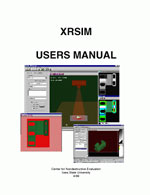X-Ray Inspection Simulation (XRSIM)
 One of the most significant recent advances in NDT has been the development and use of computer modeling that allows inspection variables to be scientifically and mathematically evaluated. In a few cases, these models have been combined with a graphical user interface to produce inspection simulation programs that allow engineers and technicians to evaluate the inspectability of a component in a virtual computer environment. One such program, XRSIM, was designed and developed at Iowa State University's Center for Nondestructive Evaluation. The program simulates radiographic inspections using a computer aided design (CAD) model of a part to produce physically accurate simulated radiographic images. XRSIM allows the operator to select a part, input the material properties, input the size, location, and properties of a defect. The operator then selects the size and type of film and adjusts the part location and orientation in relationship to the x-ray source. The x-ray generator settings are then specified to generate a desired radiographic film exposure. Exposure variables are quickly and easily revised allowing the operator to make and see results of defect size, material, and part or defect orientation.
One of the most significant recent advances in NDT has been the development and use of computer modeling that allows inspection variables to be scientifically and mathematically evaluated. In a few cases, these models have been combined with a graphical user interface to produce inspection simulation programs that allow engineers and technicians to evaluate the inspectability of a component in a virtual computer environment. One such program, XRSIM, was designed and developed at Iowa State University's Center for Nondestructive Evaluation. The program simulates radiographic inspections using a computer aided design (CAD) model of a part to produce physically accurate simulated radiographic images. XRSIM allows the operator to select a part, input the material properties, input the size, location, and properties of a defect. The operator then selects the size and type of film and adjusts the part location and orientation in relationship to the x-ray source. The x-ray generator settings are then specified to generate a desired radiographic film exposure. Exposure variables are quickly and easily revised allowing the operator to make and see results of defect size, material, and part or defect orientation.
The almost instantaneous results produced by simulation programs make them especially valuable in education and training settings. Successful radiography depends on numerous variables that affect the outcome and quality of an image. Many of these variables have a substantial effect on image quality and others have little effect. Using inspection simulation programs, inspections can be modified and the resulting images viewed and evaluated to assess the impact these variables have on the image. Many inspection scenarios can be rapidly modeled since the shot setup and exposure can be quickly accomplished and the film-developing step is eliminated. Not only can a greater number and variety of problems be explored, but also the effects of variables can be learned and self-discovered through experimentation, which is one of the most effective modes of learning. Results are not complicated by unnecessary variables such as film processing variables and artifacts. Distractions unrelated to the primary learning exercise are eliminated. Through the use of simulation programs a more effective understanding of the scientific concepts associated with radiography will be developed.
 Another important aspect of the program is that it does not require a real part for the inspections. Inspections can be simulated that would otherwise be impossible or too costly to perform outside the computer environment. Flaws of various shapes, sizes, and materials can be easily introduced into the CAD model to produce a sample set for probability of detection exercises.
Another important aspect of the program is that it does not require a real part for the inspections. Inspections can be simulated that would otherwise be impossible or too costly to perform outside the computer environment. Flaws of various shapes, sizes, and materials can be easily introduced into the CAD model to produce a sample set for probability of detection exercises.
It should be noted that densities produced in the simulated images may not match exactly the images produced in the laboratory using similar equipment settings. The difference between the actual and simulated radiographs are due to variations in the X-ray spectrum of various tubes and approximations made in the scattering model used to keep the computation times reasonable. As scattering effects become more dominant, the predicted density will agree less with the actual density on the radiograph. For example, when a one-inch steel sample is radiographed at 250 keV, over half of the total flux reaching the detector is due to scattering.
For more information on how the XRSIM program operates, the users manual is available here for downloading. The educational version of the program is available commercially.
Download the XRSIM Users Manual
Ten X-ray inspection exercises have been developed by the Collaboration for NDT Education that make use of XRSIM program. Educators can download these lessons from this site.